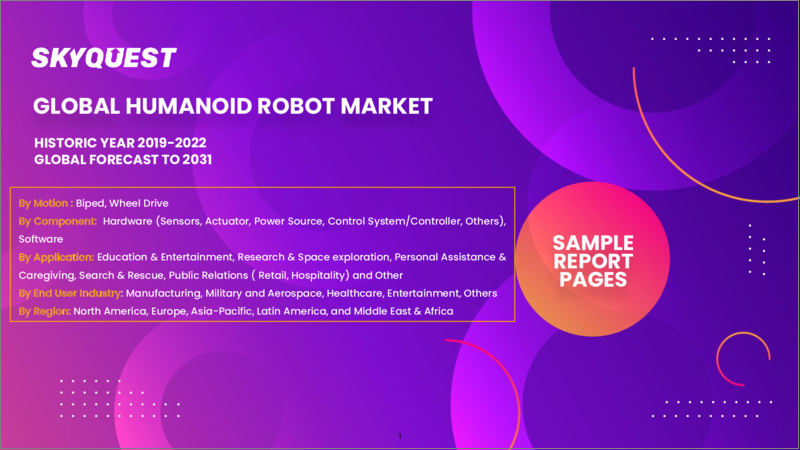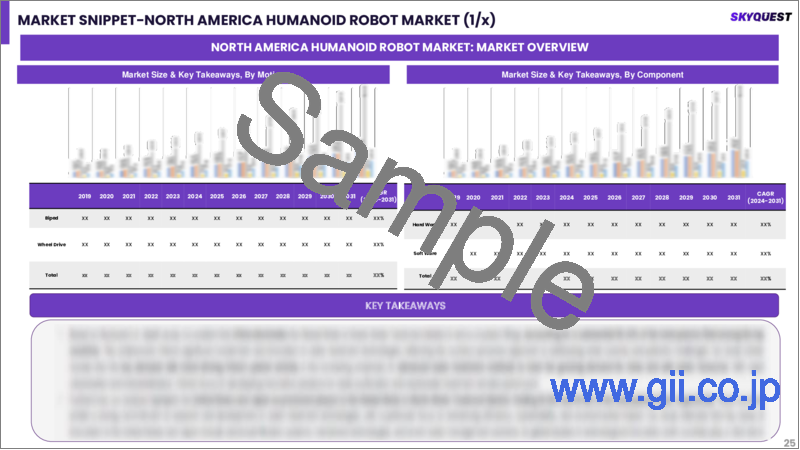|
|
市場調査レポート
商品コード
1527812
ヒューマノイドロボットの市場規模、シェア、成長分析、コンポーネント別、モーションタイプ別、用途別、地域別 - 産業予測、2024年~2031年Humanoid Robot Market Size, Share, Growth Analysis, By Component, By Motion Type, By Application, By Region-Industry Forecast 2024-2031 |
||||||
|
|||||||
| ヒューマノイドロボットの市場規模、シェア、成長分析、コンポーネント別、モーションタイプ別、用途別、地域別 - 産業予測、2024年~2031年 |
|
出版日: 2024年07月23日
発行: SkyQuest
ページ情報: 英文 157 Pages
納期: 3~5営業日
|
- 全表示
- 概要
- 目次
世界のヒューマノイドロボット市場は、2022年に15億3,000万米ドルとなり、2023年の23億米ドルから上昇し、予測期間中(2024年~2031年)にCAGR50%で2031年までには589億5,000万米ドルに達すると予測されています。
人間の外見や行動を模倣して設計されたヒューマノイドロボットは、自己学習、環境との相互作用、自己メンテナンスなどの高度な機能を備えています。ヘルスケア、エンターテインメント、製造、教育など幅広い用途で、これらのロボットは複雑なタスクに取り組むために採用されることが増えています。ヒューマノイドロボット市場は、革新的な製品の採用と相まって、小売業や学術分野での用途拡大などの要因によって大きな成長を遂げています。COVID-19パンデミックは当初、サプライチェーンや生産を混乱させましたが、医療スタッフのサポートや物資の配送にヒューマノイドロボットが導入されたことで、ヘルスケアにおけるヒューマノイドロボットの可能性も浮き彫りになりました。全体として、技術の進歩、業界全体の需要の高まり、パンデミックから学んだ教訓が、ヒューマノイドロボット市場を前進させています。
目次
イントロダクション
- 調査の目的
- 定義
- 市場範囲
調査手法
- 情報調達
- 二次・一次情報源
- 市場規模予測
- 市場の前提条件と制限
エグゼクティブサマリー
- 市場概要見通し
- 供給需要動向分析
- セグメント別機会分析
市場力学と見通し
- 市場力学
- 促進要因
- 機会
- 抑制要因
- 課題
- ポーターの分析
主要な市場の考察
- 主要な成功要因
- 競合の程度
- 技術分析
- サプライチェーン分析
- 特許分析
- 価格分析
- 貿易分析
- 主要な投資機会
- 市場の魅力指数
- 市場エコシステム
- ケーススタディ分析
ヒューマノイドロボット市場:コンポーネント別
- 市場概要
- ハードウェア
- センサー
- ジャイロスコープ
- マイク
- 加速度計
- 傾斜センサー
- 力/トルクセンサー
- 位置センサー
- ビジョン/画像センサー
- その他
- アクチュエータ
- 電気
- 空気圧
- 油圧式
- 圧電
- 超音波
- 電源
- 制御システム
- コントローラ
- ソフトウェア
ヒューマノイドロボット市場:モーションタイプ別
- 市場概要
- 二足歩行
- 車輪駆動
ヒューマノイドロボット市場:用途別
- 市場概要
- 教育・研究
- 宇宙探査
- パーソナルアシスタンス
- 介護
- 広報
ヒューマノイドロボット市場規模:地域別
- 市場概要
- 北米
- 米国
- カナダ
- 欧州
- ドイツ
- スペイン
- フランス
- 英国
- その他欧州地域
- アジア太平洋
- 中国
- インド
- 日本
- 韓国
- その他アジア太平洋
- ラテンアメリカ
- ブラジル
- その他ラテンアメリカ地域
- 中東・アフリカ(MEA)
- GCC諸国
- 南アフリカ
- その他中東・アフリカ地域
競合情勢
- 上位5社の比較
- 主要企業の市場ポジショニング(2023年)
- 主要な市場企業が採用した戦略
- 市場における最近の活動
- 主要企業の市場シェア(2023年)
主要企業プロファイル
- SoftBank Robotics(Japan)
- Honda Motor Co., Ltd.(Japan)
- Toyota Motor Corporation(Japan)
- ROBOTIS(South Korea)
- KAWADA ROBOTICS CORPORATION(Japan)
- UBTECH Robotics Corp. Ltd.(China)
- HANSON ROBOTICS LTD.(Hong Kong)
- PAL Robotics(Spain)
- HYULIM Robot Co., Ltd(South Korea)
- Engineered Arts Limited(UK)
- Hajime Research Institute, Ltd.(Japan)
- National Aeronautics and Space Administration(NASA)(US)
- ROBO GARAGE Co., Ltd.(Japan)
- Istituto Italiano di Tecnologia(IIT)(Italy)
- Robotics Lab(Spain)
- Samsung Electronics Co., Ltd.(South Korea)
- Promobot Corp.(US)
- EZ-Robot(Canada)
- Macco Robotics(Spain)
- Boston Dynamics(US)
- Advanced Telecommunications Research Institute International(ATR)(Japan)
- Wowwee Group Limited(Hong Kong)
- Kindred, Inc.(US)
- Tesla(US)
- Agility Robotics(US)
Global humanoid robot market was valued at USD 1.53 billion in 2022 and is expected to rise from USD 2.3 billion in 2023 to reach a value of USD 58.95 billion by 2031, at a CAGR of 50% during the forecast period (2024-2031).
Humanoid robots, designed to mimic human appearance and behavior, are equipped with advanced features such as self-learning, environmental interaction, and self-maintenance. With applications spanning healthcare, entertainment, manufacturing, and education, these robots are increasingly employed to tackle complex tasks. The humanoid robot market is experiencing significant growth driven by factors such as expanding applications in retail and academia, coupled with the introduction of innovative products. While the COVID-19 pandemic initially disrupted supply chains and production, it also highlighted the potential of humanoid robots in healthcare, where they were deployed to support medical staff and deliver supplies. Overall, technological advancements, rising demand across industries, and lessons learned from the pandemic are propelling the humanoid robot market forward.
Top-down and bottom-up approaches were used to estimate and validate the size of the Global Humanoid Robots Market and to estimate the size of various other dependent submarkets. The research methodology used to estimate the market size includes the following details: The key players in the market were identified through secondary research, and their market shares in the respective regions were determined through primary and secondary research. This entire procedure includes the study of the annual and financial reports of the top market players and extensive interviews for key insights from industry leaders such as CEOs, VPs, directors, and marketing executives. All percentage shares split, and breakdowns were determined using secondary sources and verified through Primary sources. All possible parameters that affect the markets covered in this research study have been accounted for, viewed in extensive detail, verified through primary research, and analyzed to get the final quantitative and qualitative data.
Global Humanoid Robots Market Segmental Analysis
The global humanoid robot market is segmented based on components, motion type, application and region. Based on Components it is categorized into: Hardware (sensors [gyroscopes, microphones, accelerometers, tilt sensors, force/torque sensors, position sensors, vision/image sensors and others], actuator [electrical, pneumatic, hydraulic, piezoelectric and ultrasonic], power source, control system/controller), and Software. Based on Motion type it is categorized into: Biped, and Wheel Drive. Based on Application it is categorized into education and research, space exploration, personal assistance, caregiving, and public relation. Based on region it is categorized into: North America, Europe, Asia-Pacific, South America, and MEA.
Drivers of the Global Humanoid Robots Market
Technological advancements have significantly propelled the demand for and adoption of robotics across diverse applications. Humanoid robots, capable of mimicking human behavior, have emerged as a prime interface for human-robot interaction, fostering a sense of companionship. These developments are underpinned by continuous research in artificial intelligence, robotic hardware, locomotion, and human-robot interaction.
Restraints in the Global Humanoid Robots Market
While academic and industrial robots offer cost-effective solutions for simple tasks, humanoid robots face a substantial price disparity due to the intricate research and development involved in replicating human capabilities. The high cost of components, maintenance, and ongoing research poses a significant barrier to market expansion. Overcoming this challenge is crucial for the widespread adoption of humanoid robots.
Market Trends of the Global Humanoid Robots Market
Asia Pacific is a leading force in humanoid robotics, driving innovation and technological advancements. The region held a substantial 31.4% market share in 2022 and is poised to become a dominant player across various applications in the near future. As countries like China and Japan grapple with aging populations, humanoid robots are expected to play a crucial role in providing personal assistance and care for the elderly.
Table of Contents
Introduction
- Objectives of the Study
- Definitions
- Market Scope
Research Methodology
- Information Procurement
- Secondary & Primary Data Sources
- Market Size Estimation
- Market Assumptions & Limitations
Executive Summary
- Market Overview Outlook
- Supply Demand Trend Analysis
- Segmental Opportunity Analysis
Market Dynamics & Outlook
- Market Dynamics
- Drivers
- Opportunities
- Restraints
- Challenges
- Porters Analysis
- Competitive rivalry
- Threat of Substitute Products
- Bargaining Power of Buyers
- Threat of New Entrants
- Bargaining Power of Suppliers
Key Market Insights
- Key Success Factors
- Degree of Competition
- Technology Analysis
- Supply Chain Analysis
- Patent Analysis
- Pricing Analysis
- Trade Analysis
- Top Investment Pockets
- Market Attractiveness Index
- Market Ecosystem
- Case Study Analysis
Humanoid Robot Market by Component
- Market Overview
- Hardware
- Sensors
- Gyroscopes
- Microphones
- Accelerometers
- Tilt sensors
- Force/Torque Sensors
- Position Sensors
- Vision/Image Sensors
- Others
- Actuator
- Electrical
- Pneumatic
- Hydraulic
- Piezoelectric
- Ultrasonic
- Power Source
- Control System
- Controller
- Software
Humanoid Robot Market by Motion Type
- Market Overview
- Biped
- Wheel Drive
Humanoid Robot Market by Application
- Market Overview
- Education & Research
- Space Exploration
- Personal Assistance
- Caregiving
- Public Relation
Humanoid Robot Market Size by Region
- Market Overview
- North America
- USA
- Canada
- Europe
- Germany
- Spain
- France
- UK
- Rest of Europe
- Asia Pacific
- China
- India
- Japan
- South Korea
- Rest of Asia-Pacific
- Latin America
- Brazil
- Rest of Latin America
- Middle East & Africa (MEA)
- GCC Countries
- South Africa
- Rest of MEA
Competitive Landscape
- Top 5 Player Comparison
- Market Positioning of Key Players, 2023
- Strategies Adopted by Key Market Players
- Recent Activities in the Market
- Key Companies Market Share (%), 2023
Key Company Profiles
- SoftBank Robotics (Japan)
- Company Overview
- Business Segment Overview
- Financial Updates
- Key Developments
- Honda Motor Co., Ltd. (Japan)
- Company Overview
- Business Segment Overview
- Financial Updates
- Key Developments
- Toyota Motor Corporation (Japan)
- Company Overview
- Business Segment Overview
- Financial Updates
- Key Developments
- ROBOTIS (South Korea)
- Company Overview
- Business Segment Overview
- Financial Updates
- Key Developments
- KAWADA ROBOTICS CORPORATION (Japan)
- Company Overview
- Business Segment Overview
- Financial Updates
- Key Developments
- UBTECH Robotics Corp. Ltd. (China)
- Company Overview
- Business Segment Overview
- Financial Updates
- Key Developments
- HANSON ROBOTICS LTD. (Hong Kong)
- Company Overview
- Business Segment Overview
- Financial Updates
- Key Developments
- PAL Robotics (Spain)
- Company Overview
- Business Segment Overview
- Financial Updates
- Key Developments
- HYULIM Robot Co., Ltd (South Korea)
- Company Overview
- Business Segment Overview
- Financial Updates
- Key Developments
- Engineered Arts Limited (UK)
- Company Overview
- Business Segment Overview
- Financial Updates
- Key Developments
- Hajime Research Institute, Ltd. (Japan)
- Company Overview
- Business Segment Overview
- Financial Updates
- Key Developments
- National Aeronautics and Space Administration (NASA) (US)
- Company Overview
- Business Segment Overview
- Financial Updates
- Key Developments
- ROBO GARAGE Co., Ltd. (Japan)
- Company Overview
- Business Segment Overview
- Financial Updates
- Key Developments
- Istituto Italiano di Tecnologia (IIT) (Italy)
- Company Overview
- Business Segment Overview
- Financial Updates
- Key Developments
- Robotics Lab (Spain)
- Company Overview
- Business Segment Overview
- Financial Updates
- Key Developments
- Samsung Electronics Co., Ltd. (South Korea)
- Company Overview
- Business Segment Overview
- Financial Updates
- Key Developments
- Promobot Corp. (US)
- Company Overview
- Business Segment Overview
- Financial Updates
- Key Developments
- EZ-Robot (Canada)
- Company Overview
- Business Segment Overview
- Financial Updates
- Key Developments
- Macco Robotics (Spain)
- Company Overview
- Business Segment Overview
- Financial Updates
- Key Developments
- Boston Dynamics (US)
- Company Overview
- Business Segment Overview
- Financial Updates
- Key Developments
- Advanced Telecommunications Research Institute International (ATR) (Japan)
- Company Overview
- Business Segment Overview
- Financial Updates
- Key Developments
- Wowwee Group Limited (Hong Kong)
- Company Overview
- Business Segment Overview
- Financial Updates
- Key Developments
- Kindred, Inc. (US)
- Company Overview
- Business Segment Overview
- Financial Updates
- Key Developments
- Tesla (US)
- Company Overview
- Business Segment Overview
- Financial Updates
- Key Developments
- Agility Robotics (US)
- Company Overview
- Business Segment Overview
- Financial Updates
- Key Developments





